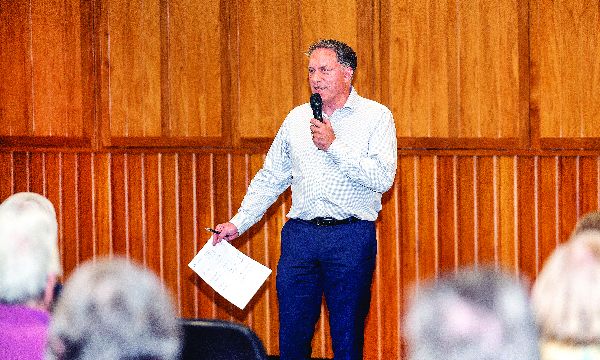
Death’s veil was lifted a little on Monday as the community discussed the honest reality of what happens to your body after you die.
The slightly morbid topic was approached with humour at a meeting organised by the Whakatane District Council to promote the new practice of natural burials in the district.
Last week, councillors voted to allow natural burials to occur at Hillcrest Cemetery and staff invited natural burial advocate Mark Blackham to speak at a community meeting.
Mr Blackham told the crowd not to be shy with their questions and that he had heard it all before, however, the Whakatane crowd still managed to surprise him with some of their thoughts.
When buried naturally, a body is placed in a shallow plot, in an environmentally-friendly coffin made of soft, untreated wood or cardboard or a shroud. Compost is placed with the body and a native tree planted on top. Eventually the natural cemetery becomes native bush and a permanent living memorial to those buried there.
Natural burials are considered better for the environment as they aid rapid decomposition and an uptake in nutrient release, whereas traditional post-death disposition practices are considered resource-heavy and can damage the environment through harmful processes such as embalming.
Topics raised at the meeting include how quickly bodies decompose after death, if animals dig bodies up, if people can be buried upright rather than laying down, and if people can be buried on their own land rather than in a cemetery.
Mr Blackham said after death families had around five days to bury a person naturally before the body began decomposing to an intolerable level, however, this was shortened to around 24 hours if a person died due to cancer as their bodies decomposed faster.
He said bodies had to be buried in the upper soil layer where the bacteria lived to allow for rapid decomposition. In 20 to 25 years there would be nothing left of the body.
“Actually, you decompose quicker above ground, but that’s not really an option for most people,” Mr Blackham said.
He assured those present that funeral directors could take care of unembalmed bodies.
Many in the crowd asked if they could make their own coffins by weaving harakeke (flax) or bamboo, or using wood.
Mr Blackham said wooden ones were fine, but people needed to make sure they weren’t too wide as this could create an “awkward” moment when a coffin wouldn’t fit into the grave – a situation he had seen before.
He said harakeke coffins would be fine but expressed concern that bamboo ones would see bamboo sprouting up through the burial site and taking over the cemetery.
Shrouds of natural fibres are also encouraged.
Mr Blackham assured the crowd that animals don’t dig up the graves.
He also said it was illegal to be buried outside of a cemetery unless a cemetery was more than 30 kilometres away from the deceased’s home.
However, he said he knew of people who had buried family members on their own land and just had not told any authorities.
Mr Blackham said it was totally up to the council how far it spaced out the graves at the natural cemetery.
He said in Wairarapa they were planting totara trees so needed four metres between burials, however, in Wellington they were “packed in tight”.
Usually there are no markers on the graves, but Mr Blackham said a wooden marker designed to degrade or a small river stone should be fine. However, the point was to get the cemetery looking as natural as possible.
Those at the meeting queried how many people could be buried in the area put aside at the Hillcrest cemetery and were told there was space for 50 to 100.
This caused some laughter with the around 80 elderly people present at the meeting clearly thinking that it would be full soon.
People also asked if they could reserve a plot, but open spaces operations manager Ian Molony said the council would not be allowing this.
This is because the site is on a hill and council staff are planning to work their way from the top down, planting as they go. To then revisit the top after planting had happened would be very difficult as staff would have to cut their way through branches and roots and it would disturb the beautiful landscape they had created.
The council will provide a list of trees that people can choose to have planted above their final resting place.
One woman asked if compost was really necessary to encourage decomposition as the “worms will find you wherever you are” and said, if it was, could it not be compost from the Kawerau worm farm which was made from sewage.
Mr Molony said the compost was necessary as some soil was not conducive to decomposition and it provided air around the body which would help it decompose faster.
He said the council was investigating natural compost options.
Council is also investigating land around the district to see if there are any other sites on which natural burials may be held.



 Eugene Doyle: The Fall Of Saigon 1975 - Fifty Years Of Repeating What Was Forgotten
Eugene Doyle: The Fall Of Saigon 1975 - Fifty Years Of Repeating What Was Forgotten Peter Dunne: Dunne's Weekly - Trump's Tariffs Still Pose Risks For New Zealand
Peter Dunne: Dunne's Weekly - Trump's Tariffs Still Pose Risks For New Zealand Keith Rankin: Barbecued Hamburgers And Churchill's Bestie
Keith Rankin: Barbecued Hamburgers And Churchill's Bestie Gordon Campbell: On Why The US Stands To Lose The Tariff Wars
Gordon Campbell: On Why The US Stands To Lose The Tariff Wars Eugene Doyle: Before It’s Too Late - Reimagine New Zealand’s Military Future
Eugene Doyle: Before It’s Too Late - Reimagine New Zealand’s Military Future  Binoy Kampmark: Gender Stunts In Space - Blue Origin’s Female Celebrity Envoys
Binoy Kampmark: Gender Stunts In Space - Blue Origin’s Female Celebrity Envoys